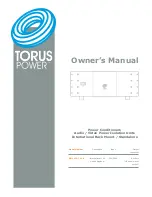
Manual 26710V1
ProTechTPS Total Protection System
Woodward
75
Process Parameter Monitoring and Trip
The logic unit has inputs to measure process parameters (continuous or discrete
signals). These signals might represent such values as lube oil pressure, thrust,
vibration, system hydraulic pressure, valve position, additional trip inputs, or other
values significant to the safety system. Comparators, Boolean logic, and timers can
be used to implement relatively sophisticated algorithms including, noise
suppression, test functions, alarming, and trip functions based on these signals.
Trip System Testing
The system can be programmed to implement the user-defined tests to activate
relay outputs (or even generate a trip from the module) to actuate a part of a trip
system. The user-configurable inputs can be defined to monitor and log the test
results. This might include monitoring a change of pressure or a limit switch to
confirm the functionality of the system tested. After the test is completed, or after
some time delay if there is a test failure, the trip test sequence can re-store the
system to the normal state. When the normal state of the system is confirmed the
user-defined test can be reset. The event latch might be used to confirm the
progress and success or failure of the test steps.
Test Routines
Each ProTechTPS module provides a variety of test routines to support common
test requirements. The ProTechTPS also supports 3 User-defined Tests.
There is a configurable test mode permissive that is provided to prevent a test from
being started if any module is tripped, in test, or in alarm. This permissive can be
configured: Not Tripped—if another module is tripped or in a test; Not In Alarm—
if another module is in alarm or in a test; or None—for no permissive. Selecting
None means that tests can be run on any module regardless of the condition of
the other modules. A test will always be prevented from running if the current
module is tripped or in test. Also, tests will be aborted if another module trips or
alarms, depending on the test mode permissive setting. One exception to these
rules is the Temporary Overspeed Trip Setpoint which can be applied to multiple
modules even if another module is tripped or in alarm. Another exception is the
Auto-Sequence Test, which will never be allowed to run if any module is tripped in
test or in alarm. Finally, the Lamp Test which can be applied to any module at
any time without a password. If a test is not permitted, or aborted, messages
displayed on the front panel explain the cause.
Any test may be initiated (or cancelled) from the ProTechTPS Front Panel.
Modbus provides commands to initiate the Auto Speed Test or any of the User-
defined Tests. User-defined Tests can be started through configurable logic – so
a discrete input might be defined to initiate a test. Finally, there is a Auto
Sequence Test function that will automatically run the Auto Speed Test on all
three modules at a user-defined interval.
For Modbus commands, a start confirmation is required and an abort
is also provided.
Содержание ProTech TPS
Страница 36: ...ProTechTPS Total Protection System Manual 26710V1 34 Woodward Figure 2 7 Inside View of ProTechTPS ...
Страница 37: ...Manual 26710V1 ProTechTPS Total Protection System Woodward 35 Figure 2 8 ProTechTPS Control Wiring Diagram ...
Страница 62: ...ProTechTPS Total Protection System Manual 26710V1 60 Woodward Figure 3 8 Simplex Trip Block Assembly ...
Страница 63: ...Manual 26710V1 ProTechTPS Total Protection System Woodward 61 Figure 3 9 Dual Redundant Trip Block Assembly ...
Страница 74: ...ProTechTPS Total Protection System Manual 26710V1 72 Woodward Figure 3 14 Start Logic Diagram ...
Страница 122: ...ProTechTPS Total Protection System Manual 26710V1 120 Woodward Advanced Menu ...
Страница 124: ...ProTechTPS Total Protection System Manual 26710V1 122 Woodward Declarations ...
















































